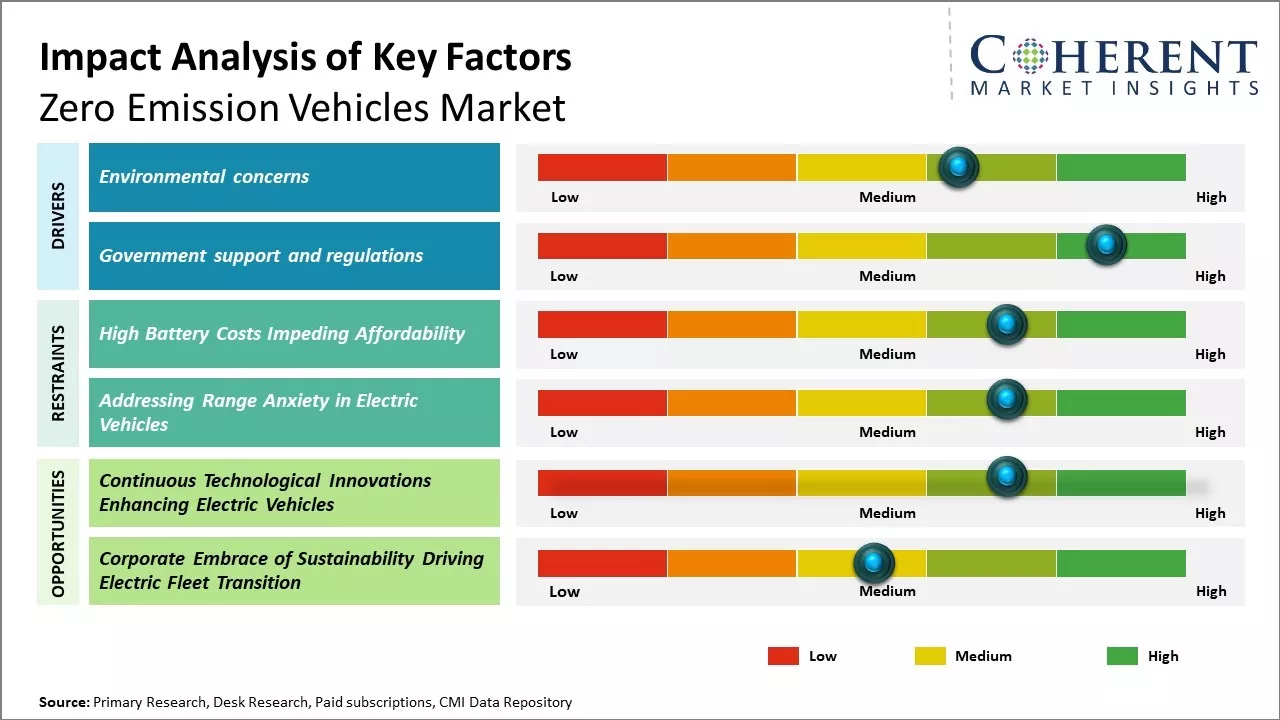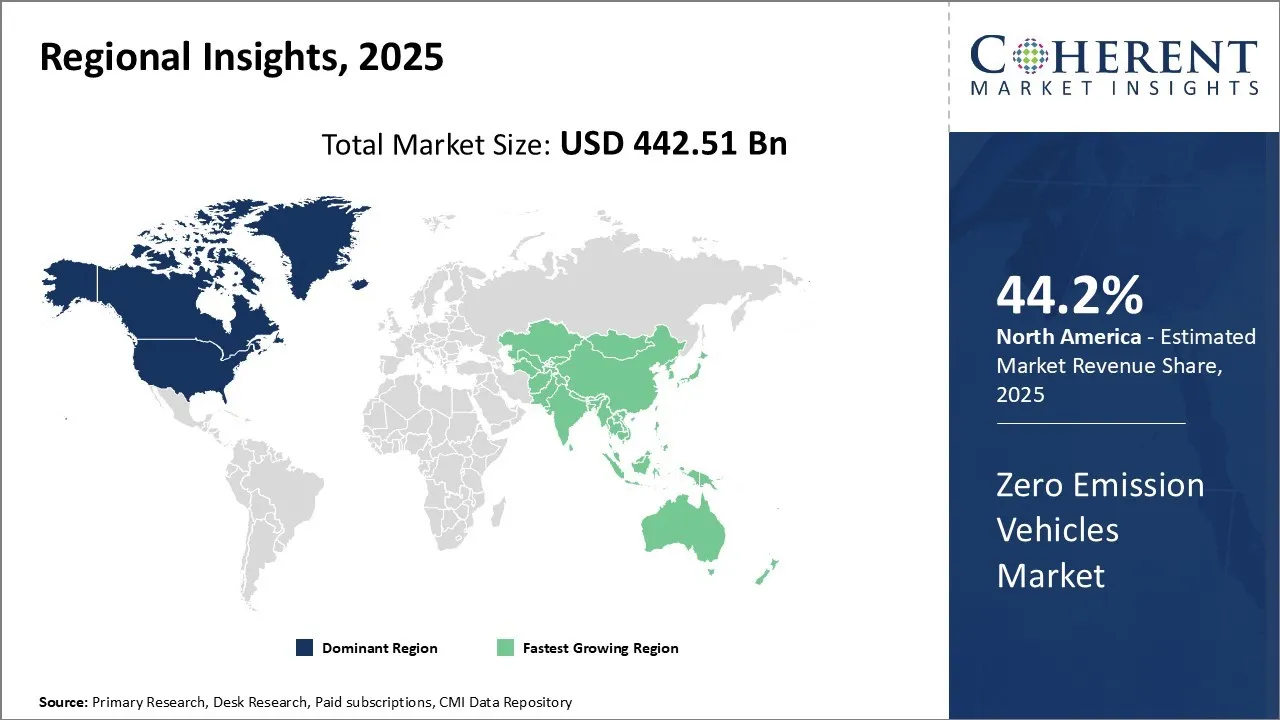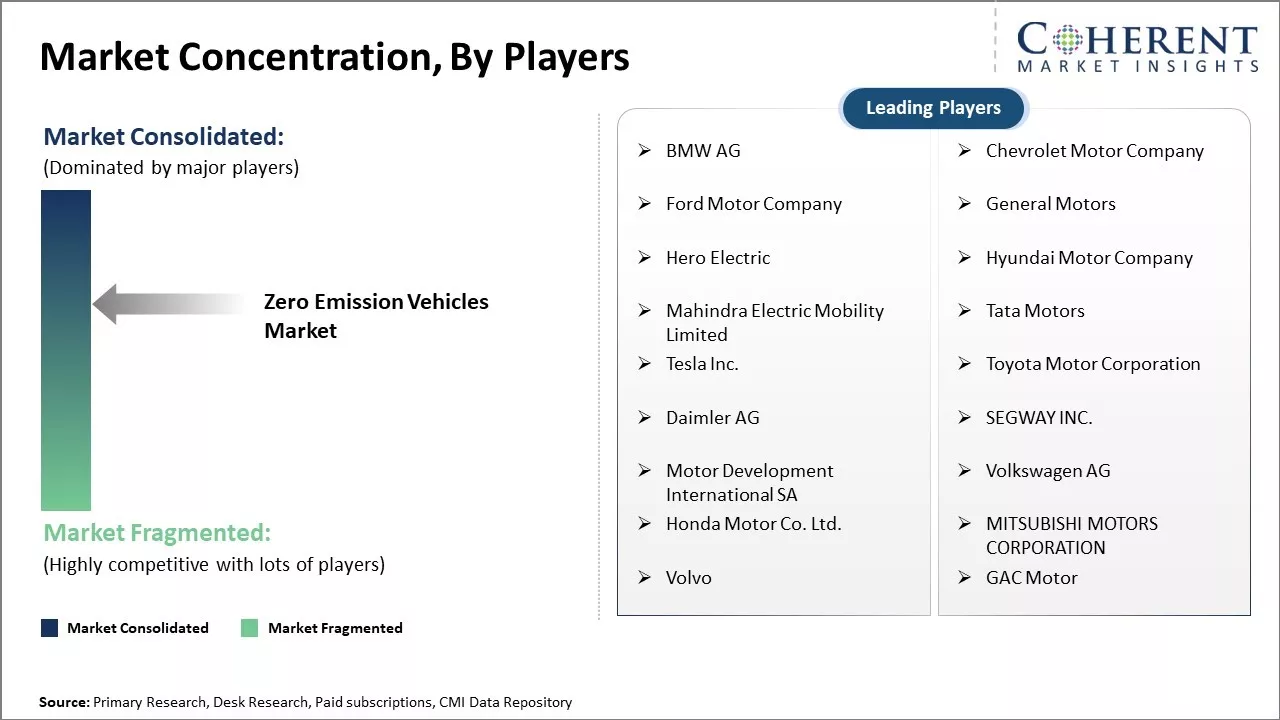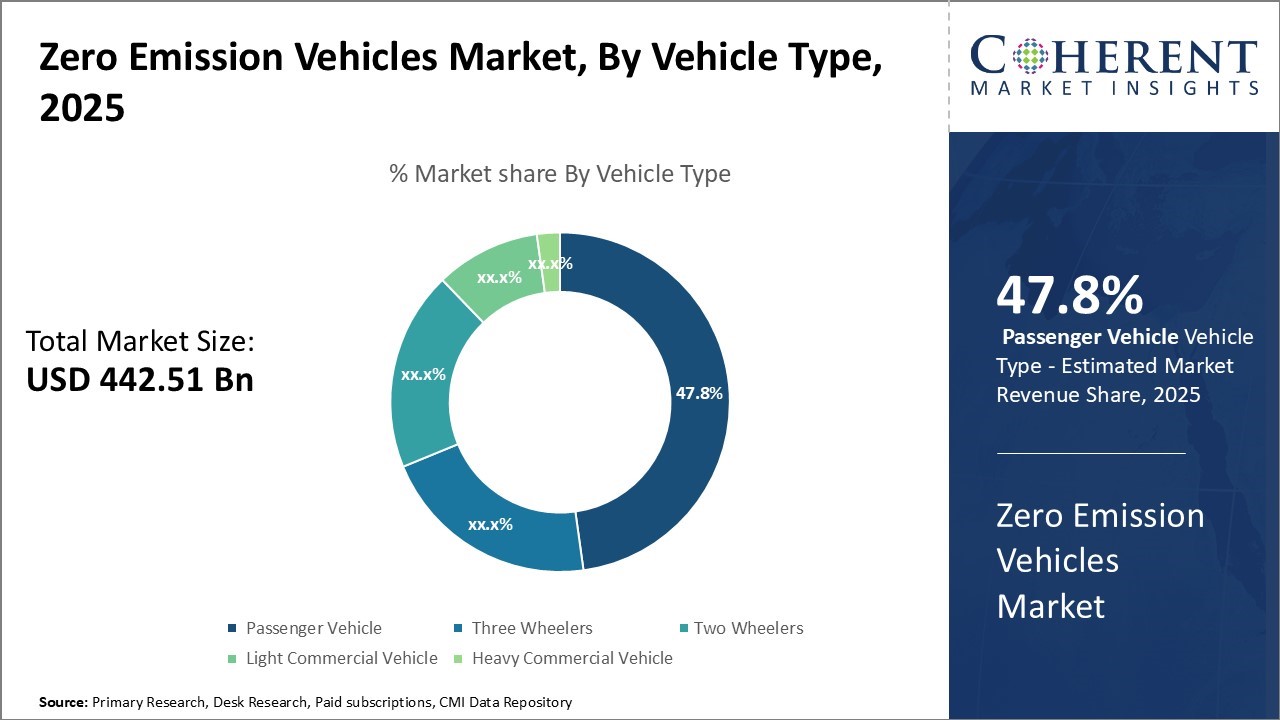Zero Emission Vehicles Market Analysis & Forecast - 2025 to 2032
Zero emission vehicles market is estimated to be valued at USD 442.51 Bn in 2025 and is expected to reach USD 1,984.56 Bn in 2032, exhibiting a compound annual growth rate (CAGR) of 23.9% from 2025 to 2032.

To learn more about this report, Download Free Sample
Key Takeaways
- According to Vehicle Type, the Passenger Vehicle Category is anticipated to account for the largest share of 47.8% for the zero emission vehicles market in 2025. Growing consumer demand, rising per capita income in developing nations, and an increase in leisure and tourism worldwide are the main drivers of this expansion.
- According to region, North America holds the largest market share of 44.2% for zero emission vehicles market growth by 2025. In this region growing fuel costs and consumer concerns about sustainability are encouraging more people to purchase ZEVs.
Market Overview
The zero emission vehicles market size is growing quickly as a result of government regulations, technical developments, and environmental concerns. The market is expected to witness a positive growth trend during the forecast period. Stringent emission norms by governments across regions to curb environmental pollution are driving the adoption of zero emission vehicles. Major automakers are heavily investing in electric vehicles to cater to the growing customer demand.
Current Events and Its Impact on the Zero Emission Vehicles Market
|
Event |
Description and Impact |
|
Government Incentives and Policy Push |
|
|
Rising Fuel Prices and Environmental Concerns |
|
Uncover macros and micros vetted on 75+ parameters: Get instant access to report
Zero Emission Vehicles Market Insights, By Vehicle Type
Passenger vehicles is estimated to contribute the largest share of 47.8% in 2025, due primarily to growing consumer demand. As the effects of climate change become ever more apparent, many individuals now prioritize reducing their environmental impact through sustainable transportation choices. Zero-emission electric vehicles allow passengers to travel in a manner that produces no tailpipe pollutants or greenhouse gas emissions.
An expanding network of charging infrastructure is also helping drive adoption of electric passenger cars. Whereas early battery-electric vehicles faced range limitations due to underdeveloped charging access, new fast-charging stations are increasingly common alongside major highways and in populated areas. Drivers no longer need to worry as much about finding a place to "refuel." Furthermore, advances in battery technology continue extending vehicle ranges, alleviating “range anxiety” concerns.
Financial incentives from government programs also play a role in propelling the passenger electric vehicle segment. Rebates and tax credits lower the upfront costs that previously presented an adoption barrier. As production volumes increase and battery prices decline, the total cost of ownership of electric cars is becoming comparable to gasoline equivalents, appealing to cost-conscious consumers. Premium electric carmakers additionally leverage their brand image and style to cater to environmentally-minded buyers seeking the latest technologies.
The continued expansion of the passenger electric vehicle market segment depends on ongoing tech improvements, supportive policies, and widespread charging provision. As battery range and power increase while pricing decreases due to economies of scale, zero-emission mobility options will appeal to ever larger portions of the driving population.
Zero Emission Vehicles Market Insights, By Propulsion
Within the zero-emission vehicles industry, battery-electric vehicles currently dominate the propulsion segment relative to hydrogen fuel cell competitors. Several defining traits give BEVs an edge over FCVs at this stage.
Most significantly, lithium-ion batteries benefiting from decades of development for consumer electronics have reached a high level of energy density, specific power, and cost-efficiency. By contrast, hydrogen fuel cells remain an emerging technology still striving for commercial viability at scale. Widespread manufacturing has yet to drive down fuel cell costs to parity with batteries. Infrastructure is also strongly battery-electric-biased, with a far more extensive public fast-charging network complementing widespread residential Level 2 charging accessibility.
Simplicity favors BEVs as well - electric drive trains involving far fewer components prove less complex and expensive to build compared to fuel cell powertrains at low production volumes. Battery swapping has also been demonstrated as a quicker “refueling” alternative to charging, especially for commercial applications. Additionally, the automotive industry currently places greater manufacturing and R&D resources toward battery technologies, benefiting from multifaceted applications across markets.
However, hydrogen fuel cell vehicles hold promise for longer-haul commercial and public transport in the future. As technical obstacles are overcome, fuel cells may gain ground, particularly for applications requiring rapid refueling. Still, battery improvements continue apace, and existing charging infrastructure momentum favors electric vehicles preserving their dominance in the zero-emission propulsion segment for the foreseeable future.
Regional Insights

To learn more about this report, Download Free Sample
North America Zero Emission Vehicles Market
North America is estimated to establish itself as the dominant market for zero emission vehicles globally with 44.2% of the market share in 2025. The region is home to leading automakers like Tesla, General Motors, and Ford who have invested heavily in electrifying their model line-ups.
Both consumers and businesses in the U.S. and Canada have shown strong appetite for EVs, especially in populous states like California which offer attractive purchase incentives and charging infrastructure. The auto industry in North America is aligning to shift from internal combustion engines to battery-powered vehicles in the near future in line with regional emission regulations.
Asia Pacific Zero Emission Vehicles Market
The Asia Pacific region, is emerging as the fastest growing market for zero emission vehicles worldwide with CAGR of 31.28%. The Chinese government has been aggressively pushing the auto sector to embrace electromobility in order to reduce air pollution levels in major cities. Substantial subsidies on electric vehicles and setting up of extensive public charging networks have made EVs an attractive alternative to gasoline vehicles.
Chinese automakers like BYD and Nio have taken the lead in the domestic EV market and are also looking at expansion overseas. Moreover, increasing raw material supply and battery production in China is supporting stronger adoption of electric vehicles across applications.
Zero Emission Vehicles Market In Europe
Europe remains an important regional market, led by Norway and the Netherlands which have very high EV penetration rates already. However, high upfront costs coupled with lack of public charging options in parts of Central and Eastern Europe has hampered faster adoption of zero emission vehicles. European automakers are now bolstering their investments in electric technology and platforms to position themselves better for upcoming emissions regulations across EU nations.
Zero Emission Vehicles Market Dominating Countries
U.S Zero Emission Vehicles Market
The U.S. government, through agencies like the Environmental Protection Agency and the Department of Energy, has implemented stringent emission regulations and incentives, including tax credits and subsidies, to accelerate ZEV adoption. Programs such as California’s ZEV mandate require automakers to sell a certain percentage of zero emission vehicles, which has significantly boosted market growth.
India Zero Emission Vehicles Market
India’s zero emission vehicle market is rapidly emerging as a key growth region within Asia Pacific, propelled by government initiatives such as the EV30@30 campaign, which aims for at least 30% of new vehicle sales to be electric by 2030. The Indian government offers various fiscal incentives, including tax reductions and subsidies, to encourage EV adoption.
Zero Emission Vehicles Market In China
China is the largest and most mature zero emission vehicle market worldwide, dominating global sales volumes and production capacity. The Chinese government has implemented aggressive policies, including subsidies, tax exemptions, and mandates for automakers to produce a minimum share of EVs.
Market Report Scope
Zero Emission Vehicles Market Report Coverage
| Report Coverage | Details | ||
|---|---|---|---|
| Base Year: | 2024 | Market Size in 2025: | USD 442.51 Bn |
| Historical Data for: | 2020 To 2024 | Forecast Period: | 2025 To 2032 |
| Forecast Period 2025 to 2032 CAGR: | 23.9% | 2032 Value Projection: | USD 1,984.56 Bn |
| Geographies covered: |
|
||
| Segments covered: |
|
||
| Companies covered: |
BMW AG, Chevrolet Motor Company, Ford Motor Company, General Motors, Hero Electric, Hyundai Motor Company, Mahindra Electric Mobility Limited, Tata Motors, Tesla Inc., Toyota Motor Corporation, Daimler AG, SEGWAY INC., Motor Development International SA, Volkswagen AG, Honda Motor Co. Ltd., MITSUBISHI MOTORS CORPORATION, Volvo, and GAC Motor |
||
| Growth Drivers: |
|
||
| Restraints & Challenges: |
|
||
Uncover macros and micros vetted on 75+ parameters: Get instant access to report
Market Concentration and Competitive Landscape

To learn more about this report, Download Free Sample
Zero Emission Vehicles Market: Growth Drivers
- Environmental concerns
There is a growing concern among consumers and governments regarding the impact of vehicular emissions on the environment. Vehicles powered by internal combustion engines emit harmful gases such as nitrogen oxides, carbon monoxide, hydrocarbons, and particulate matter which are the major contributors to air pollution in many cities.
The transportation sector accounts for a significant portion of overall carbon emissions and governments are actively working to reduce the carbon footprint of this industry. Many countries and states have enacted stricter emission norms over the past decade while also offering incentives to consumers to adopt cleaner vehicles.
- Zero Emission Vehicles and government regulations
Government policies play a major role in encouraging the adoption of new technologies in the automotive industry. Governments around the world are supporting the development and uptake of zero emission vehicles through various fiscal and non-fiscal incentives. They offer subsidies and tax rebates for purchases of electric vehicles to make them affordable for consumers. Some countries have implemented quotas for car manufacturers to ensure a minimum sale of green vehicles. Restrictive emission norms are being made more stringent over the years.
In January 2023, the California Energy Commission (CEC) approved a substantial funding of USD 2.93 billion for enhancing California's zero-emission transportation infrastructure. This funding, authorized in December 2022, aims to expand Electric Vehicle chargers, zero-emission vehicles, transit and school buses, and hydrogen refueling equipment. California is set to receive an additional 90,000 EV chargers, requiring an investment of USD 900 million.
The state currently has around 80,000 EV chargers. A significant portion of the funding, USD 1.71 billion, is allocated for the infrastructure of medium- and heavy-duty Zero Emission Vehicles (ZEVs), following the California Energy Commission’s approval of zero-emission vehicle infrastructure and USD 1.42 billion in funding for 2021.
Zero Emission Vehicles Market: Trends
- Increasing digital transformation of enterprises around the world is a growing trend
Due to digital transformation of enterprises, the emergence of automation powered by digital technologies such as AI and robotics is increasing around the world. This is likely to help companies reduce cost of manufacturing. The use of robotic filling equipment allows packagers to create more than they can with manual product filling.
This technology can enable dependable, repeatable, and consistent fill with every cycle, whether the fill is based on a volume, level, weight, or another measurement. Thus, growing digital transformation of enterprises to fuel growth of the global Zero Emission Vehicles market during the forecast period.
Zero Emission Vehicles Market: Opportunities
- Continuous Technological Innovations Enhancing Electric Vehicles
Global efforts to reduce urban air pollution and mitigate carbon emissions are driving government support policies. Electric vehicles have lower fueling and maintenance costs which appeal to fleet operators and companies focused on sustainability. Technological innovations are steadily extending driving ranges while reducing battery costs.
Zero Emission Vehicles Market: Key Developments
- In June 2025, Convergence Energy Services Ltd (CESL) prepared to roll out a nationwide tender for 10,900 electric buses. The initiative, undertaken as part of the National Electric Bus Programme (NEBP), underscored the government’s commitment to accelerating the development of clean, sustainable, and zero-emission public transport infrastructure.
- In March 2025, The Indian Institute of Technology Madras (IIT Madras) launched ‘Zero e-Mission’, a comprehensive set of e-mobility initiatives across diverse domains, ranging from education, skilling, and research to policy, outreach, and safety.
Analyst Opinion
- Ambitious national and regional decarbonization targets, stricter government restrictions aimed at emissions, and significant government incentives like tax breaks and subsidies are driving this expansion.
- Technology advancements are improving vehicle performance and price, particularly in the areas of battery chemistry, vehicle design, and charging infrastructure, opening up ZEVs to a wider spectrum of buyers.
- The move away from internal combustion engines is also being accelerated by rising fuel prices and more environmental consciousness.
- Despite North America's current market dominance, the Asia-Pacific area is predicted to grow at the highest rate due to its sizable, risingly wealthy population and robust legislative backing.
Market Segmentation
- By Vehicle Type
- Two Wheelers
- Three Wheelers
- Passenger Vehicle
- Light Commercial Vehicle
- Heavy Commercial Vehicle
- By Propulsion
- Battery electric vehicles (BEVs)
- Hydrogen fuel cell vehicles (FCVs)
- By Regional
- North America
- U.S.
- Canada
- Latin America
- Brazil
- Argentina
- Mexico
- Rest of Latin America
- Europe
- Germany
- U.K.
- Spain
- France
- Italy
- Russia
- Rest of Europe
- Asia Pacific
- China
- India
- Japan
- Australia
- South Korea
- ASEAN
- Rest of Asia Pacific
- Middle East
- GCC Countries
- Israel
- Rest of Middle East
- Africa
- South Africa
- North Africa
- Central Africa
- Key Players Insights
- BMW AG
- Chevrolet Motor Company
- Ford Motor Company
- General Motors
- Hero Electric
- Hyundai Motor Company
- Mahindra Electric Mobility Limited
- Tata Motors
- Tesla Inc.
- Toyota Motor Corporation
- Daimler AG
- SEGWAY INC.
- Motor Development International SA
- Volkswagen AG
- Honda Motor Co. Ltd.
- MITSUBISHI MOTORS CORPORATION
- Volvo
- GAC Motor
Sources
Primary Research interviews
- OEM executives (e.g., from Tesla, BYD, Hyundai, Toyota)
- EV battery manufacturers (e.g., CATL, Panasonic, LG Energy Solution)
- Government transport and energy regulators
- Urban mobility planners
- EV fleet operators (e.g., Uber, Amazon Logistics)
- EV charging infrastructure providers
Databases
- International Energy Agency (IEA)
- World Bank Open Data
- United Nations Economic Commission for Europe (UNECE)
- International Council on Clean Transportation (ICCT)
- European Environment Agency (EEA)
- U.S. Energy Information Administration (EIA)
Magazines
- Automotive News
- Green Car Journal
- EV Magazine
- AutoCar
- TopGear (EV coverage)
- CleanTechnica (industry-focused)
Journals
- Journal of Cleaner Production
- Transportation Research Part D Transport and Environment
- Renewable and Sustainable Energy Reviews
- Energy Policy
- IEEE Transactions on Vehicular Technology
- Nature Energy
Newspapers
- The Guardian (Environment section)
- The New York Times (Climate and Autos sections)
- The Wall Street Journal (Autos and Tech)
- Financial Times (EV and Sustainability)
- The Economic Times (Auto and Energy)
Associations
- International Zero-Emission Vehicle Alliance (IZEVA)
- Society of Automotive Engineers (SAE)
- Electric Vehicle Association (EVA)
- European Automobile Manufacturers Association (ACEA)
- Zero Emission Transportation Association (ZETA)
- California Air Resources Board (CARB)
Proprietary Elements
- CMI Data Analytics Tool
- Proprietary CMI Existing Repository of information for last 8 years
*Definition: Zero Emission Vehicles (ZEVs) are vehicles that produce no tailpipe emissions or pollutants during operation. Unlike traditional internal combustion engine vehicles that burn fossil fuels and emit carbon dioxide (CO2) and other harmful gases, ZEVs rely on alternative power sources such as electricity or hydrogen fuel cells to power their motors.
Share
Share
About Author
Ameya Thakkar is a seasoned management consultant with 9+ years of experience optimizing operations and driving growth for companies in the automotive and transportation sector. As a senior consultant at CMI, Ameya has led strategic initiatives that have delivered over $50M in cost savings and revenue gains for clients. Ameya specializes in supply chain optimization, process re-engineering, and identification of deep revenue pockets. He has deep expertise in the automotive industry, having worked with major OEMs and suppliers on complex challenges such as supplier analysis, demand analysis, competitive analysis, and Industry 4.0 implementation.
Missing comfort of reading report in your local language? Find your preferred language :
Transform your Strategy with Exclusive Trending Reports :
Frequently Asked Questions
EXISTING CLIENTELE
Joining thousands of companies around the world committed to making the Excellent Business Solutions.
View All Our Clients

